![]()
![]()
![]()
Use LEFT and RIGHT arrow keys to navigate between flashcards;
Use UP and DOWN arrow keys to flip the card;
H to show hint;
A reads text to speech;
55 Cards in this Set
- Front
- Back
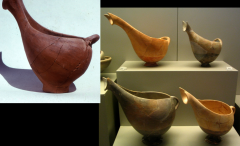
|
EH II Sauceboats - all handmade - evidence that people are now living on the mainland, eg. Lerna |
|
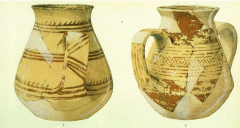
|
Patterned Ware (tankards) EH III - found at Lerna, after it was re-inhabited - potter's wheel is also found at this time, indicating new people, although it does not become popular until the MH |
|

|
Megaron - this is the typical house shape on the mainland - several large, well-built megaron were found at Lerna, they had stone foundations and mud-brick upper walls |
|
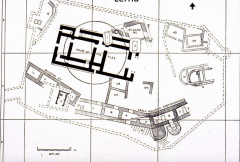
|
Lerna, site in the Peloponnese - dug by the Americans in the 50s and was done well - 7 phases of occupation, there was a break after the Neolithic - houses are well built and the money put into the community shows thriving, not just surviving - there were fortification walls with guard towers, showing need for defence, and the presence of an administrative structure to organize the building of the walls |
|
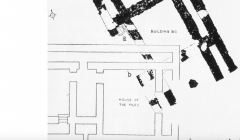
|
Lerna, Building BG, corridor house - this building was important, seemed palatial and was partly covered up by the House of the Tiles - it is too big and complex to be a regular house, could it have been for a communal purpose like storing grain or as a site of worship? - evidence for a more permanent type of settlement |
|

|
Lerna, House of the Tiles, built partly on top of Building BG - corridor house, roof was tiled - stairs to a second floor, thick walls to support - 25x12 metres, similar to later temples proportions - replacement for BG? - seals found here= admin, marks possessions for storage - burnt down at the end of EH II along with other towns |
|

|
Lerna, Sealings from the House of the Tiles - they mark possessions for storage and redistribution - represents a group of people |
|
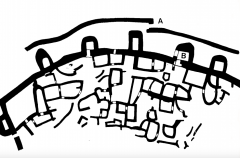
|
Khalandriani, Syros - pots date from EC II, but burnt at the end of EC II, like Lerna on the mainland - houses made of dry stone masonry - 2 defensive walls w guard towers and a narrow entrance (shows they had things to protect) - small, packed houses on a hillside - cist graves with many offerings |
|
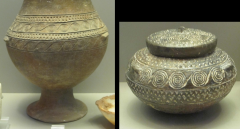
|
EC II incised ware - common spiral shape |
|
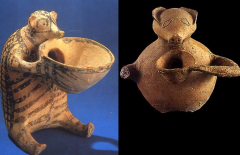
|
EC II zoomorphic pots - shows that the Cycladics were creative and experimental, sense of humour - clay pots |
|
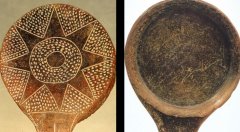
|
EC II frying pans - the bottom of the pans is decorated - maybe it was a symbol of female fertility or maybe it was used for mixing pigments - images of spirals and ships (which had no sails) |
|

|
EC II, folded-arm figurine - best example of common stylized figurines - usually small, though they can be lifesized - long and thin, carved from one block - usually female, but have little anatomical detail - feet on tippy toes, maybe meant to be lying down - figures were exported and made for 500 years (only in EC II) - religion? fertility? they don't look fertile |
|
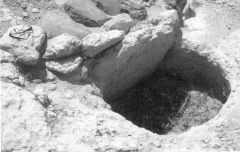
|
Crete, EM chamber-tomb like grave - almost all the graves were communal - pottery was found in the graves, including HO ware |
|

|
EM Hagois Ounuphrios Ware - light with red paint, made from a mixture of clay and water - the beaked water jug, shown here, was very popular - this is evidence of contact with Troy |
|
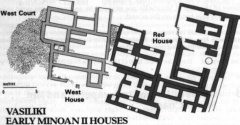
|
Vasiliki (East end of Crete), EM houses - before this in EM I, there was not much evidence for settlements - important settlement - unlike mainland, as there were no megarons or fortification walls - 1/2 rooms, have store houses, some houses are more complex (4 of these were found), and perhaps this indicates a leader, multi-family, beginning of palatial trend |
|
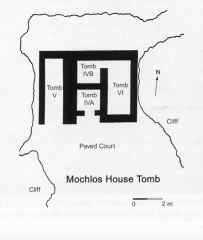
|
EM Burials, "cities of the dead," like houses - in the EM II period, burials became more elaborate and permanent - 4-13m in diameter - also had round communal tombs, could hold 100s of bodies - seals often found with different nature scenes |
|

|
EM II, Vasiliki Ware - very nice kind of pottery - molted decoration done by uneven firing (trying to imitate marble/stone?) - sometimes used paints - all handmade and well done |
|
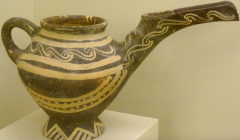
|
EM III, light on dark ware - used because Vasiliki designs were hard to control, and they started using more paints - this shape with the elongated spout is common - designs show waves= love of nature |
|

|
MH, Minyan Ware goblet - named this by Schliemann after King Minas - biggest change after settlements were re-inhabited - usually wheel-made, well-fired, glossy, smooth, has a soapy feel |
|

|
MH, matt-painted ware - still hand-made and coexisting with Minyan ware - polychromy and shows continuity from EH III patterned ware (tankards) - shows contact with Cyclades and Crete - by the late MH, this was fused with yellow Minyan ware to create the basis for later Mycenaean pots |
|
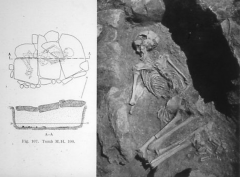
|
MH cist grave, continues from EH - type of inhumation burial - small, walled chambers with a slab roof - bodies are contracted (knees drawn up) - now few offerings (more poor, change in beliefs, placed on top and lost over time) - almost always inhumation (same ppl?), but now there are some intramural burials (new!) |
|
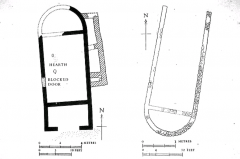
|
MH Apsidal houses, new in EH III Left: Korakou Right: Olympia - hearth is now in the centre - now there is no town planning, and no evidence for one main building (did not continue the trend of the protopalaces) |
|
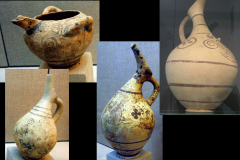
|
MC II, curvilinear - looks like abstract florals, appears after rectilinear designs, more free-flowing |
|

|
MC III (naturalistic), polychrome ware - progression from curvilinear - birds and plants are common subjects - influence from Crete - animals and plants are in natural settings |
|
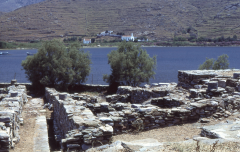
|
Ayia Irini site, in a protected bay on Kea - used a lot of stone in the building process - occupied from EC to LC (break from EC III to MC, fortification built then) - quite prosperous, some planning - one different building, in which many figures were found, has many rooms (worship?) |
|
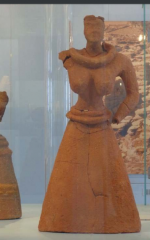
|
Ayia Irini figures from (so-called) temples - 1.2 m tall, clay - like Minoan and Theran figures |
|
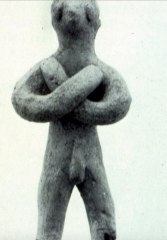
|
MM, Mt, Juktas peak sanctuary figurine - evidence of religion, has fortification walls and may have been used as a place to hide for defence - pithoi for food found here |
|

|
MM, Petsofa (East Crete) peak sanctuary figurine - evidence of religion - many votives found of both genders, animals and body parts (likely for healing) - figures are painted and bare-breasted - likely represent individuals - evidence for larger-scale worship |
|
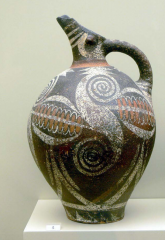
|
MM II: Kamares Ware, time of great artistry - the paint is generally poorer than that of the Em period (flaky) - this is a culmination of the decorative and abstract trend, lively, and some plants are stylized, some more natural - wheel made |
|
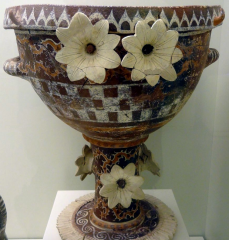
|
MM Barbotine Ware - many raised dots, and some raised flowers - can be seen as excessive |
|
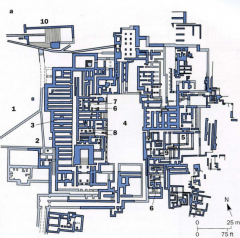
|
Knossos plan - 20 000 sqm. - at least 600 year history, first built in the Early MM - see slide with attributes of a palace - earthquakes gave them to opportunity to build bigger and better MM III and Arthur's reconstructions are what we see today - "Knossos" seen on Roman coins (with the minotaur and labyrinth on the reverse) The name is also used on Linear B tablets - centre of town activity - built on flat ground, did not fear an attack |
|
|
Features of a Palace |
- he dug from 1900-1905, and spent 20 years working an remodelling Arthur Evans and team on the grand staircase at Knossos (Fyfe and Mackenzie) - his Victorian upbringing influenced him, saw this as a potential home for the royal - 4/5 floors - they used original materials fortified with concrete and steel - his reconstructions are often controversial, as he went beyond what he needed to for conservation (he used colours he had seen on frescoes, and mimicked the shape of the columns, originally made with Cyprus trees) |
|
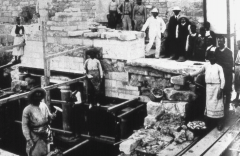
|
Theatral Area, Knossos - paved area with stairs to stand and watch (what? We do not know, perhaps ritual performances, we see this in some of the frescoes) |
|
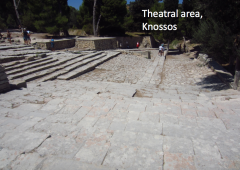
|
Queen's Megaron, Knossos - named by Arthur Evans, his Victorian past influenced him - shows how we have to be careful with how we interpret things, dolphin mural now thought to be meant for the floor - perhaps a bathing area for priestesses? - partitions let in air and light |
|
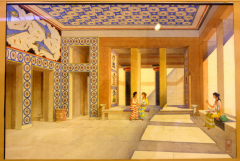
|
Bull's head rhyton, Knossos - ritual vase - example of great Minoan art - what is the bull's role (worship/sacrifice?) - double axe may just symbolize the palace - bull leaping as seen in many fescoes |
|
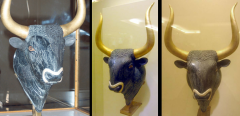
|
Throne Room, Knossos - this is where Evans' conservation begun - LM II date: not Minoan original - throne is original, walls were rebuilt and painted, but the gryphons should be winged - perhaps the throne was made for women's proportions |
|
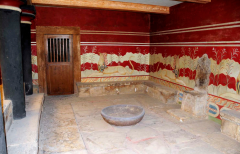
|
Phaistos plan (this name also seen on coins) - built on a hill, but likely for views, not defence - how did this palace relate to Knossos? trade partners? - 8400 sqm, half the size of K (part of the palace has fallen down the hillside) - MM I, a little later than K - not restored, Mycenaeans do not take over after the invasion - has same palatial features, likely a gallery above the central courtyard, private apartments had a garden - appears to be built more uniformly |
|
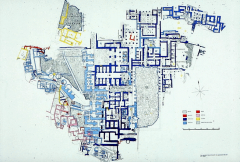
|
Theatral Area, Phaistos - was remodelled in MM II, and steps were added for 500 spectators |
|
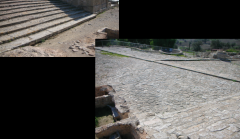
|
Theatral Area, Phaistos - was remodelled in MM II, and steps were added for 500 spectators |
|
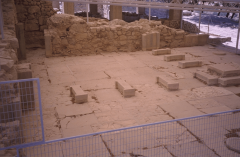
|
Mallia plan - quite close to K, how does that work? - on flat ground near the coast (trade), no defence walls - part of town - 8 000 sqm. - was destroyed around 1450 - typical palatial features - courtyard is different on all four sides, and is beaten earth, not as fancy - religious/ cult rooms found, w altar and offerings - |
|
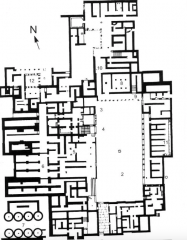
|
Town of Gournia - on Easter Crete, on the coast, quite hilly, no defence walls - dug by Harriet Hawes, same time as Evans - destroyed with other palaces - houses were well built with stone and mud brick upper walls - working town, craftsmen (bronze weapons and tools pottery, textiles, ect.), trade networks with Egypt |
|
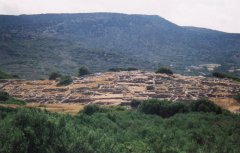
|
Town of Gournia plan - palace within the city (likely the home of the local ruler - looks like big palace, houses are in blocks, narrow roads, hilly streets - generally high standard of living |
|
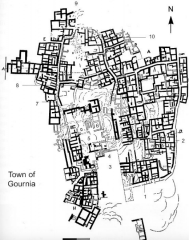
|
Tylissos, House A(lpha) - very well built, dates to the height of the Minoan Bronze age (MM II- LM I) - N half is for storage (reception rooms above?) - S is the main living area and has the typical features of a Minoan house, lightwells, hall, treasuries, storage, pillar crypt, bathroom with toilet and drain |
|
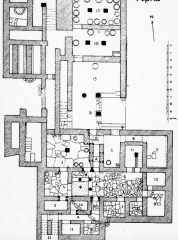
|
Tylissos, House A(lpha) - very well built, dates to the height of the Minoan Bronze age (MM II- LM I) - N half is for storage (reception rooms above?) - S is the main living area and has the typical features of a Minoan house, lightwells, hall, treasuries, storage, pillar crypt, bathroom with toilet and drain |
|
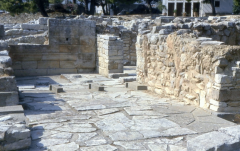
|
House of the Chancel Screen - different because of the half wall with columns and steps up to a platform with a "seat of honour" - Evans rebuilt part of it, and it seems that houses have smaller versions of palatial features |
|
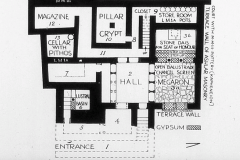
|
Partridge and Hoopo Fresco, Knossos MM II-III - combined naturalistic images and abstract design (brightly coloured eggs, repeating ground, black cave-like background, water) |
|

|
MM dance fresco - ceremonial scenes are popular in MM II - shows crowds of people, men in red with less detail (arms raised cheering), and women in white and more individualized (some sitting below olive trees) - dancing looks static, wall surrounding dancing area - helped Evans understand the theatral area - public gatherings, division between men and women |
|
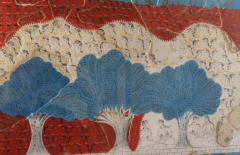
|
MM Grandstand (Temple Fresco) - many men in red, women larger and in white - tripartite shrine and columns - quite formal, so no earlier than LM I - where is this taking place? - shows the Horns of Consecration (look like Egyptian symbol for mountains- Mount Ida?) - Evans got column and colour ideas from this - women prominent- matriarchy? - |
|
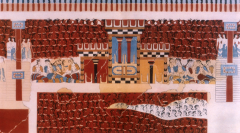
|
Cup-barer fresco, part of the Procession Fresco - male carrying rhyton ritual vase - seemingly Egyptian kilt - some wearing dresses have red feet- men - |
|
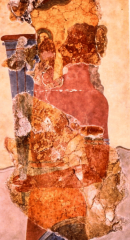
|
Captain of the Blacks Fresco - LM II, usual to have a military scene (sign of a new group in control) - Africans, slaves, mercenaries? |
|
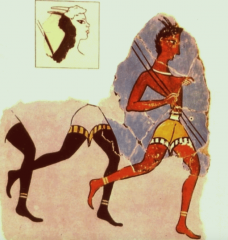
|
- Re-habitation after the Neolithic age (Lerna) - towns well built/ admin/ fortification - EH II the best time, prosperity and trade - Lerna and other towns burnt at the end of EH II - EH III, new settlement, new people (no fortifications and apsidal houses) MH: worse time, Eg. Malthi is a poor site, messy, no "big house" like before, regression back to stone tools as opposed to metal - were these the first Greek speakers, words like Kno-ssos show a language before Greek |
|
|
Timeline of the Mainland (Helladic) |
- Re-habitation after the Neolithic age (Lerna) - towns well built/ admin/ fortification - EH II the best time, prosperity and trade - Lerna and other towns burnt at the end of EH II - EH III, new settlement, new people (no fortifications and apsidal houses) MH: worse time, Eg. Malthi is a poor site, messy, no "big house" like before, regression back to stone tools as opposed to metal - were these the first Greek speakers, words like Kno-ssos show a language before Greek |
|
|
Timeline of the Cyclades (Cycladic) |
- Crete is distinct, and have their own traditions, pottery, tombs and social structure - EM II a lively period of progress in architecture, and pottery. Some say settlements dominated by a large house. Communal burials. - MM, no destructions on Crete: this is when we see cities, palaces, trade, strong central government, and maybe even an empire |
|
|
Timeline of Crete (Minoan) |
- Crete is distinct, and have their own traditions, pottery, tombs and social structure - EM II a lively period of progress in architecture, and pottery. Some say settlements dominated by a large house. Communal burials. - MM, no destructions on Crete: this is when we see cities, palaces, trade, strong central government, and maybe even an empire |
|
|
Features of a Palace |
- central courtyard (walls around this nicely done, sim. to Roman forum, assembly space for general population, sporting area w bull, rituals, marketplace, ect. ?) - theatral area - grand staircase - pier-and-door partitions - storerooms - residential quarters - multiple stories - plumbing and sewage system - complex with many rooms - pillar crypts - light wells |

